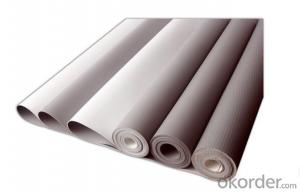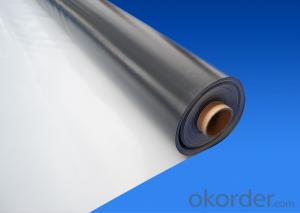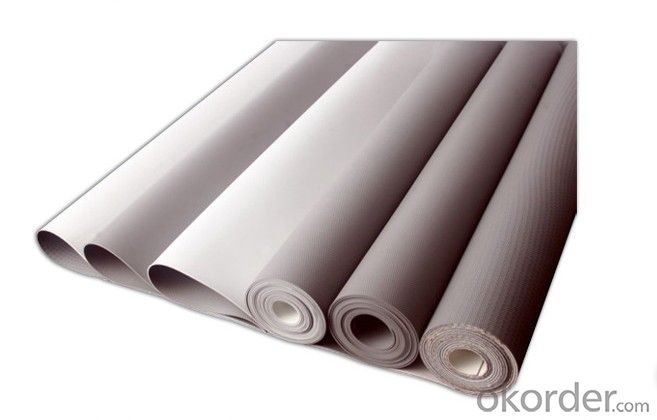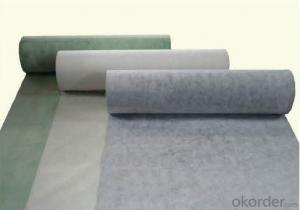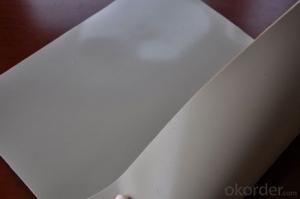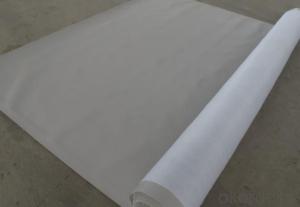Polyvinyl Chloride Waterproofing Membrane
- Loading Port:
- China main port
- Payment Terms:
- TT OR LC
- Min Order Qty:
- 10000 m²
- Supply Capability:
- 300000 m²/month
OKorder Service Pledge
OKorder Financial Service
You Might Also Like
1.Structure of PVC Waterproofing Membrane Description:
c is a kind of excellent high quality, high polymer waterproof sheet, the PVC resin to join plasticizer, anti-uv agent, anti-aging agent, stabilizing agent, such as processing AIDS, by extrusion molding of polymer adhesive waterproofing materials. Product has high tensile strength, elongation, good stability, small shrinkage rate, good low temperature flexibility, good ageing resistance, strong root penetration resistance, long service life, is the key recommended products by the ministry of construction, especially its wide amount to 2.05 meters, waterproof layer to minus the many seams, and polyvinyl chloride (PVC) thermoplastic gives the coil can be hot air welding and vigilant fixed performance, so as to thoroughly solve the has plagued the construction industry caused by poor performance of glue permeation leakage problems.
2.Main Features of PVC Waterproofing Membrane:
Long service life, resistant to ageing.
High tensile strength, high elongation rate.
Good low temperature flexibility.
Good root permeability resistance
Conveniente for construction,Solid and pollution-free.
3.Specification of PVC Waterproofing Membrane:
| Index | ||||
| Tensile Strength (Mpa) ≥ | 10 | |||
| Elongation at break% | 200 | |||
Fracture strength( kN/m)≥ | 40 | |||
Low temperature bending,℃≤ | -20 |
4.PVC Waterproofing Membrane Images:
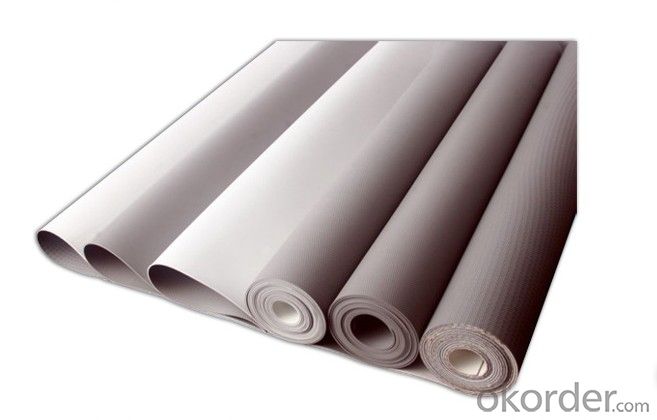
- Q: Can a waterproofing membrane be used for a bridge deck construction?
- Yes, a waterproofing membrane can be used for bridge deck construction. A waterproofing membrane is a thin layer of material that is applied to the bridge deck to prevent water infiltration and protect the underlying structure from corrosion and deterioration. It is commonly used in bridge deck construction to ensure the longevity and durability of the bridge. The waterproofing membrane acts as a barrier against moisture, preventing water and other liquids from penetrating the bridge deck surface. This is particularly important for bridge decks, as they are constantly exposed to various weather conditions, including rain, snow, and ice, which can cause damage over time. In addition to its water resistance properties, a waterproofing membrane also provides protection against other elements such as UV rays and chemicals, which can degrade the bridge deck surface. By preventing water and other harmful substances from reaching the bridge deck, the waterproofing membrane helps to extend the lifespan of the bridge and reduce maintenance and repair costs. Furthermore, a waterproofing membrane can also improve the overall safety of the bridge by reducing the risk of structural damage caused by water infiltration. By keeping the bridge deck dry, the membrane helps to maintain the integrity of the bridge and prevents potential hazards such as slippery surfaces or weakened structural components. Overall, a waterproofing membrane is a crucial component in bridge deck construction as it ensures the long-term functionality and durability of the bridge. Its ability to provide protection against water infiltration, UV rays, and chemicals makes it an ideal choice for enhancing the performance and lifespan of a bridge.
- Q: Can waterproofing membranes be used on expansion joints?
- Yes, waterproofing membranes can be used on expansion joints. These membranes are designed to create a barrier against water penetration and can effectively seal and protect expansion joints from moisture damage.
- Q: Can a waterproofing membrane be used on precast lead surfaces?
- Precast lead surfaces can benefit from the application of a waterproofing membrane. These membranes are commonly used to safeguard various types of surfaces, such as precast concrete, metal, or lead surfaces. By forming a reliable barrier against water penetration, these membranes effectively keep the underlying structure dry and well-protected. To achieve optimal results, it is crucial to thoroughly clean, dry, and remove any contaminants from the precast lead surface before applying the waterproofing membrane. This step promotes proper adhesion and enhances the membrane's ability to prevent water infiltration. For specific guidance on using a waterproofing membrane on precast lead surfaces, it is advisable to seek professional advice or consult the manufacturer's guidelines.
- Q: Can a waterproofing membrane be applied on top of existing waterproofing systems?
- Yes, a waterproofing membrane can be applied on top of existing waterproofing systems. This additional layer can provide extra protection and reinforce the existing waterproofing system, ensuring better resistance against water infiltration and extending the lifespan of the waterproofing.
- Q: What is a waterproofing membrane?
- A waterproofing membrane is a thin layer or sheet made of materials like bitumen, rubber, or synthetic polymers that are applied to surfaces to prevent water penetration. It acts as a barrier, protecting structures such as roofs, basements, or foundations from water damage and leaks.
- Q: How does a waterproofing membrane compare to other waterproofing methods?
- A waterproofing membrane is a highly effective and reliable method of waterproofing compared to other traditional waterproofing methods. Here are some ways in which a waterproofing membrane stands out: 1. Superior Protection: A waterproofing membrane provides a continuous and seamless barrier against water intrusion. Unlike other methods like waterproof paints or coatings, which may crack or peel over time, a membrane can withstand extreme weather conditions and prevent water from seeping through. 2. Longevity: Waterproofing membranes are designed to be durable and long-lasting. They are usually made from materials such as rubber, PVC, or modified bitumen, which have excellent resistance to wear and tear. As a result, they can provide a reliable waterproofing solution for many years. 3. Versatility: Waterproofing membranes can be applied to various surfaces, including concrete, metal, and wood. They can be used in a wide range of applications such as roofs, basements, foundations, and even tunnels. This versatility makes them suitable for both residential and commercial projects. 4. Flexibility: Waterproofing membranes are flexible, allowing them to conform to the shape and contours of the surface they are applied to. This flexibility ensures that the membrane can accommodate any movements or shifts in the structure, preventing any potential cracks or gaps that could lead to water leakage. 5. Ease of Installation: Installing a waterproofing membrane is usually straightforward and can be done by professionals or experienced DIYers. The membrane is typically rolled out onto the surface, adhered with adhesive or heat-welded, and then sealed at the edges and seams. This ease of installation makes it a popular choice for both new construction and retrofit projects. 6. Cost-Effectiveness: While the initial cost of installing a waterproofing membrane may be higher compared to other methods, its long-term cost-effectiveness makes it a wise investment. The durability and longevity of the membrane mean that there will be fewer maintenance and repair costs over time, saving money in the long run. In conclusion, a waterproofing membrane offers superior protection, longevity, versatility, flexibility, ease of installation, and cost-effectiveness compared to other waterproofing methods. Its ability to provide a continuous and reliable barrier against water intrusion makes it a preferred choice for many construction projects.
- Q: SBS modified asphalt waterproofing membrane and synthetic polymer membrane the same, not the same, what is the difference?
- SBS modified asphalt waterproofing membrane is a kind of high-polymer modified asphalt waterproofing membrane, high polymer modified asphalt waterproofing membrane is synthetic polymer modified asphalt coating layer,
- Q: Are there any specific maintenance requirements for a waterproofing membrane?
- Yes, there are specific maintenance requirements for a waterproofing membrane. Regular inspections should be conducted to check for any signs of damage or deterioration, such as cracks or leaks. Any debris or standing water should be promptly removed to prevent potential damage. Additionally, it is important to follow the manufacturer's guidelines for cleaning and maintenance, which may include periodic cleaning with mild detergents and avoiding the use of harsh chemicals or abrasive cleaning tools.
- Q: Can a waterproofing membrane improve energy efficiency?
- Yes, a waterproofing membrane can improve energy efficiency. A waterproofing membrane acts as a barrier against moisture intrusion, preventing water from seeping into the building envelope. By keeping the structure dry, it helps to prevent the growth of mold and mildew, which can contribute to poor indoor air quality and the deterioration of building materials. In addition to protecting against moisture, a waterproofing membrane can also provide insulation benefits. Many waterproofing membranes are designed to have a high thermal resistance, or R-value. This means that they can provide an extra layer of insulation to the building, reducing heat transfer through the walls or roof. By improving the building's thermal performance, a waterproofing membrane can help to reduce the load on heating and cooling systems, resulting in energy savings and improved energy efficiency. Furthermore, a waterproofing membrane can also help to reduce air leakage in a building. Air leakage can account for a significant amount of energy loss, as conditioned air escapes through gaps and cracks in the building envelope. By sealing off these areas, a waterproofing membrane can help to improve the building's air tightness, reducing energy loss and improving energy efficiency. Overall, a waterproofing membrane can play a crucial role in improving energy efficiency by preventing moisture intrusion, providing additional insulation, and reducing air leakage. Investing in a high-quality waterproofing system can lead to long-term energy savings, improved indoor comfort, and a more sustainable and efficient building.
- Q: Can a waterproofing membrane be used on roofs with solar panels?
- Yes, a waterproofing membrane can be used on roofs with solar panels. In fact, it is important to ensure the roof is properly waterproofed to protect the underlying structure and prevent any water damage. The waterproofing membrane can be installed around the solar panels, ensuring a watertight seal and maintaining the integrity of the roof.
Send your message to us
Polyvinyl Chloride Waterproofing Membrane
- Loading Port:
- China main port
- Payment Terms:
- TT OR LC
- Min Order Qty:
- 10000 m²
- Supply Capability:
- 300000 m²/month
OKorder Service Pledge
OKorder Financial Service
Similar products
Hot products
Hot Searches
Related keywords
